Optimal contract strategy for 300U capital (efficient flipping plan)
Core Principle: Strict position sizing, only trade BTC+/ETH+ | Stop-loss > Take-profit | Limit of 3 times
I. Starting Stage: 300U → 1100U (3-level sprint)
Strategy: 100U × 3 times, each time with 10x leverage, 7% take-profit / 5% stop-loss (risk-reward ratio 1.4:1)
Execution Steps: Level 1 (100U → 200U) Target: Profit 70U (7% take-profit) Stop-loss: -50U (5%) Success → Enter Level 2, Failure → Remaining 200U adjust strategy
Level 2 (200U → 400U) Target: Profit 140U Stop-loss: -100U Success → Level 3, Failure → Remaining 100U as a safety net
Level 3 (400U → 800U) Target: Profit 280U Stop-loss: -200U Success → Principal reaches 1100U, enter stable strategy
Key Discipline: Up to 3 times! Regardless of success or failure, switch to a conservative approach and only trade BTC/ETH, rejecting altcoins (poor liquidity, high risk of price spikes)
II. 1100U Phase: Three-Dimensional Matrix Strategy (Ultra-Short + Swing + Trend)
Capital allocation: ultra-short trades (300U) → 15-minute quick in-and-out swing trades (500U) → 4-hour level trading + regular BTC investments
Trend trading (200U) → Weekly major opportunity sniper reserve (100U) → Emergency replenishment / sudden opportunity
Ultra-short trades (300U, intraday trading)
Strategy: 10x leverage, EMA12 + MACD + (5, 13, 1) signal Entry: 15-minute candlestick breaks above the last 3 highs + volume increase
Profit: 3%~5% (flexible trailing stop-loss) Stop-loss: 2% Mandatory stop-loss circuit breaker: 2 consecutive losses → pause for 1 hour
2. Swing trades (500U, 4-hour level)
Strategy: 5x leverage, Bollinger Bands narrow breakout entry: 4H Bollinger Band width < 20% annual line, break above upper band to go long / below lower band to go short Stop-loss: 1.5 times band width Profit management: Weekly profit of 40% for regular BTC investment
3. Trend trading (200U, weekly opportunities) Strategy: 3x leverage, wait for extreme market conditions: Weekly RSI + (14) < 30 (oversold) or >70 (overbought) 3 consecutive candlesticks in the same direction on the daily chart 4-hour TD sequence += 9 (reversal signal) Take-profit: move stop-loss, risk-reward ratio ≥ 3:1
III. Ultimate Risk Control (Lifeline)
Single-day loss > 15% → Mandatory rest for 24 hours Weekly profit > 30% → Halve leverage the next day Monthly withdrawal of 20% profit → Lock in gains
Summary: The first three levels (100U × 3 times) → Rapidly accumulating capital stage (1100U) → Ultra-short + swing + trend combination discipline > technique! Reject holding positions, reject frequent trading
By following this approach, one can achieve high returns while controlling risks, making it suitable for players starting with 300U!
This method is also one I have personally tested: from February to March 2025, in one month, I turned 5000 into 100,000! Achieving a profit rate of 2108.17%!
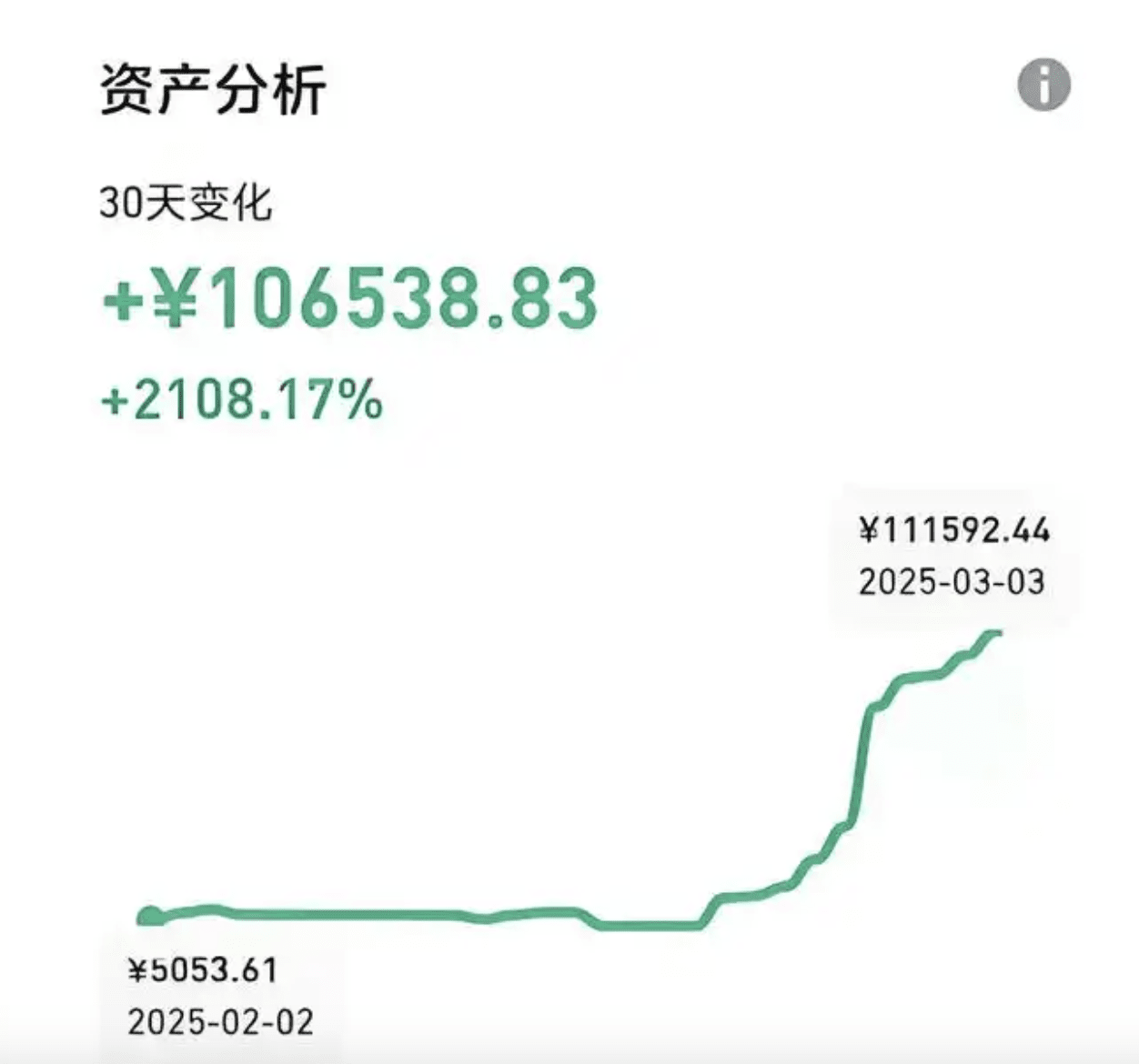
Next, let's introduce two methods of position management!
1. Left-side position management
1) Don’t deploy all your capital at once; buy in batches!!!
2) You can divide your capital into several portions; when uncertain about the bottom, buying in batches is the most suitable method for averaging down the cost!!!
(3) The bottom for adding to positions should be handled flexibly based on market conditions; do not add frequently, as that would adversely affect the cost averaging; entering 20%, 30%, or 50% is suitable for aggressive investors keen on bottom fishing!!!
(4) The initial investment amount is relatively small, and if the purchased cryptocurrency does not rise and continues to fall, gradually increase the position, with increasingly larger increments to average down the cost. This approach has relatively low initial risk, and the higher the funnel, the more considerable the profits!!
2. Right-side position management
(1) Buy 1: When the 5-day moving average crosses above the 10-day moving average, increase by 30%!!
(2) Buy 2: When the price effectively breaks above the lifeline, increase by 30% when it retraces to the lifeline, ensuring that the total position at the beginning of the upward trend reaches 60%!
(3) Buy 3: When breaking the neckline or other significant pressure levels, re-test and stabilize, indicating that the reversal pattern has been established; increase the position by another 20%. The total position should reach 80%, hold for further gains!!
(4) Buy 4: When the price is above the lifeline and a golden cross occurs between the 5-day and 10-day moving averages, it is a typical signal for acceleration; at this point, the remaining 20% of the position should also be bought in time to maximize profits!!!
9 Survival Rules for Short-Term Trading in Cryptocurrency!
1. You must learn to wait; contracts are like passing the drum, a surge of emotions will inevitably lead to adjustments, and panic will soon be followed by reversals. Use 20% of the opportunity to earn 80% of the return; this is an irreversible law of the market.
2. Never over-leverage; over-leveraging can lead to emotional trading and a vicious cycle. Losses are normal; the key is your mindset and finding new opportunities. To profit, first prioritize capital preservation.
3. Exercise caution when buying; do not be impulsive due to a straight-line rise; in a large market, there are many opportunities. You should consider indices and sentiment to make judgments.
4. Cutting losses must be decisive; when expectations are not met, make swift decisions without wasting time on losses, and look for new opportunities.
5. After a big profit, it is necessary to withdraw; a big profit often means the market is very euphoric, and corrections will follow. Timely withdrawals can clear the frenzy and add color to life.
6. Respect the market; do not make subjective judgments about the market. If the funds have not chosen a direction, there is no need to hold on. Engaging in the direction recognized by the market is the right path.
7. Do not carry on after a climax; the market has reached a peak, and the game of passing the flower is about to end. Who will be willing to take over the next day?
8. Try not to trade in the afternoon; the short-term situation is usually clear by the morning session, and trades should have already been executed. Streamline your trades to avoid unnecessary entanglement.
9. Persist in reflecting and summarizing; failure is not scary, what is scary is gaining nothing. Let every failure become the foundation for success, so you can go further.
My method of trading cryptocurrencies is very simple and practical; I turned a small sum into eight figures in just one year by waiting for the right opportunity to enter, not trading without a setup, and maintaining a winning rate above 90% for five years!
I can say that I have used 80% of the methods and techniques in the market, but only the following indicators are the most practical, having caught many tenfold and hundredfold coins! Ignoring this graphic could mean losing at least 20%!
If you want to treat stock trading as a second career to support your family, you must seriously study this article, as it can save you at least 10 years of detours!
We have discussed 'breakout trading' many times before; it is an effective way to quickly follow up when a new trend emerges. The best breakouts usually occur when the price breaks through a very clear resistance level that is monitored by many market participants. At this time, market momentum tends to increase sharply, attracting more buyers to enter, thereby pushing prices higher.
However, capturing these breakouts is not as easy as it seems. In this article, we will discuss four different entry methods for breakout trading, each with its own advantages and disadvantages.
Remember to choose the method that best suits your trading style to improve your chances of success!
How to enter breakout trades?
Determine breakout levels
Traders first need to identify the key price levels or technical indicators for the breakout. This could be trendlines, moving averages, or resistance levels.

Option 1: Buy before the breakout
It is entirely possible to buy before the actual breakout occurs, which is also known as 'anticipating the breakout.' However, there is no doubt that this approach is riskier than the other options discussed below.
If you decide to take this approach, be sure to only select those stocks or varieties that show strong momentum and have increased volume prior to the breakout.
The main advantage of this method is that if the breakout indeed occurs, you will quickly profit because you anticipated the breakout in advance. However, the breakout may ultimately not happen, or it may fail.
Traders using this strategy typically start with light positions to test before buying again during or after the breakout to establish multiple positions.
Entry and stop-loss
Buy when prices are still in a consolidation phase. The initial stop-loss is usually set below the consolidation trading channel.
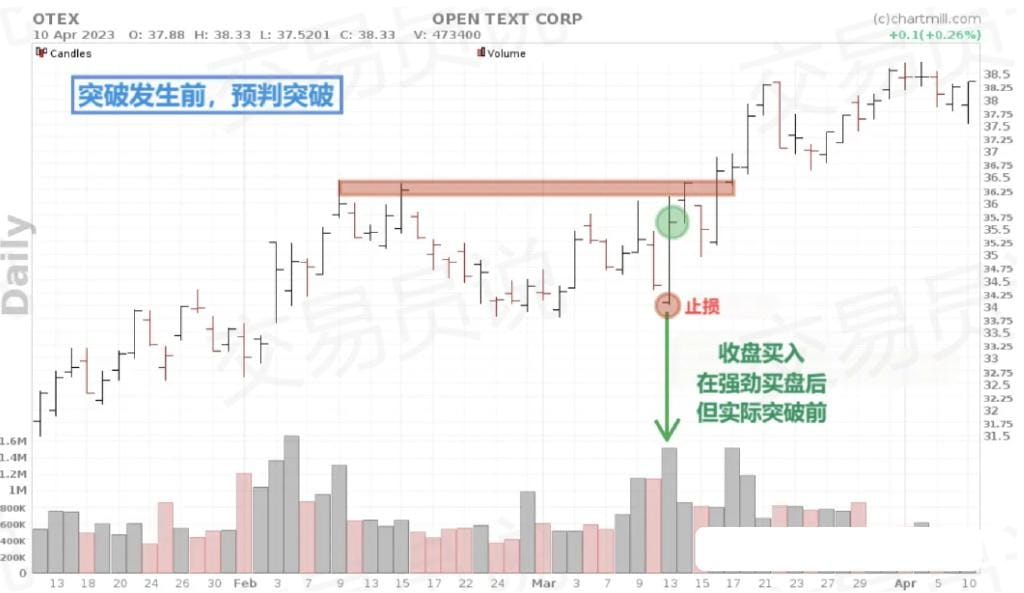
Option 2: Buy at the breakout
Buying at the breakout ensures that an effective breakout has indeed occurred. For this option, it is equally important to monitor momentum and volume closely. Stronger momentum and higher volume are early signals of increased buyer interest. This is much more reliable than predicting the success probability of a breakout.
Similar to Option 1, buying during a strong breakout offers the chance for quick profits.
However, there is still the possibility of false breakouts. On the daily chart, false breakouts often appear as prices break during trading hours but the closing price ultimately falls below the breakout level.
In this case, traders need to decide whether to hold on (assuming the breakout will eventually occur) or to close positions immediately and wait for prices to attempt a breakout again.
Entry and stop-loss
Once the price breaks above the established breakout level, buy immediately. Stop-loss can be set below the last candlestick (aggressive) or below the consolidation range (conservative).
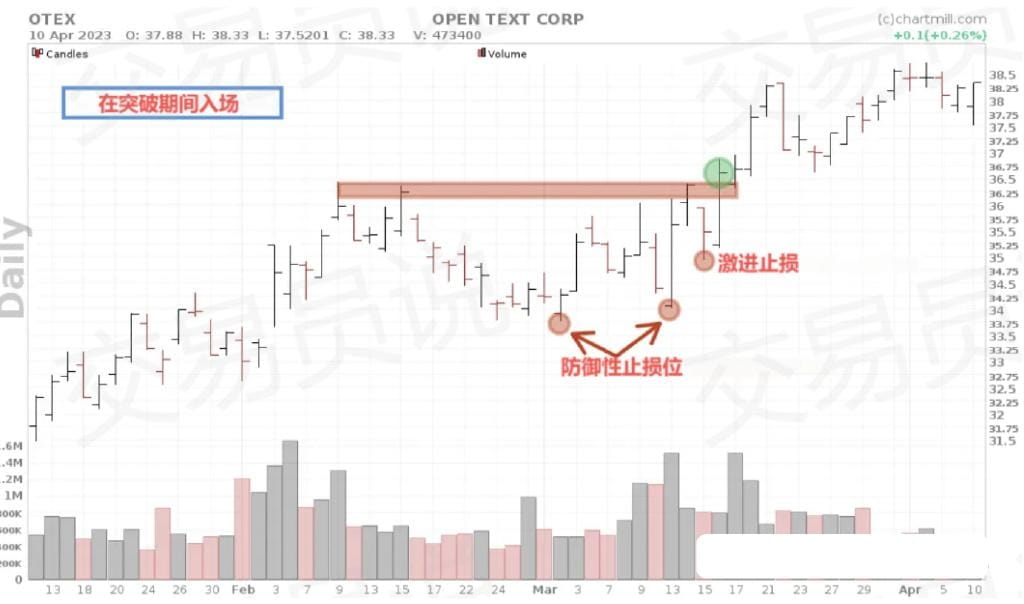
Option 3: Buy after the breakout
Option 3 is a more conservative strategy, but its advantage lies in providing a higher level of certainty. Not only has the breakout occurred, but it is also confirmed because the closing price at the end of the trading day is above the breakout level. This eliminates the possibility of intraday false breakouts.
One major drawback of waiting for confirmation of a breakout is that you may miss part of a significant price increase. Breakouts of 10%, 15%, or even more often occur. Not all traders are willing to enter after the price has already risen significantly.
Additionally, there remains the possibility that the price may retreat back below the breakout level on the next trading day. Therefore, the risk of a breakout failure still exists, just not on the day of the breakout.
Entry and stop-loss
Buy once the price closes above the determined resistance level. The closing price depends on the selected time frame. In this case, the stop-loss can be set just below the breakout candlestick (aggressive) or slightly lower to give the price more room for fluctuation, avoiding an early stop-loss (conservative).
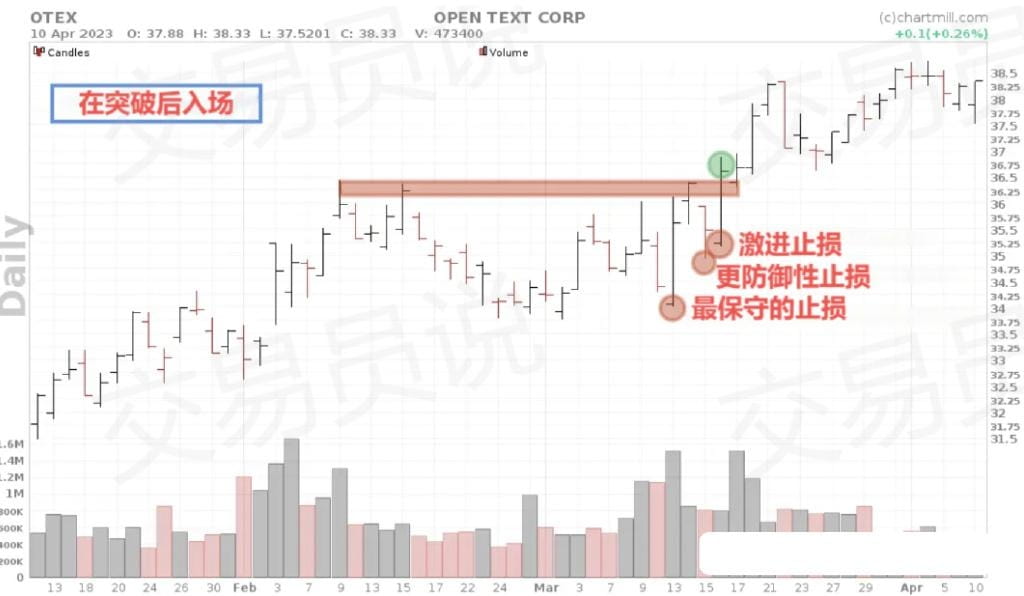
Option 4: Buy after the breakout retracement
The last method is the most conservative. First, like Option 3, wait for a confirmed breakout to occur. Then, wait for the price to retrace to the breakout level before entering.
Successful retracements are additional confirmation signals after a breakout. This trading method requires traders to have immense patience and the ability to resist the temptation to enter early. Those using this method must accept that if no retracement occurs after the breakout and prices immediately continue to rise, many breakout opportunities will be missed.
Some traders use retracement methods to expand their initial (light position testing) positions to full positions. In this case, the manner of retracement is very important. The decline that leads prices back to the initial breakout level should be controlled, and the selling volume should be lower than the previous buying volume.
Entry and stop-loss
Buy after the price retraces to the initial breakout level. Buy when the price retraces to the initial breakout level and shows a reversal signal. Stop-losses are usually set just below the breakout level. However, you can also choose a more conservative approach by using the previous swing low as a stop-loss level.
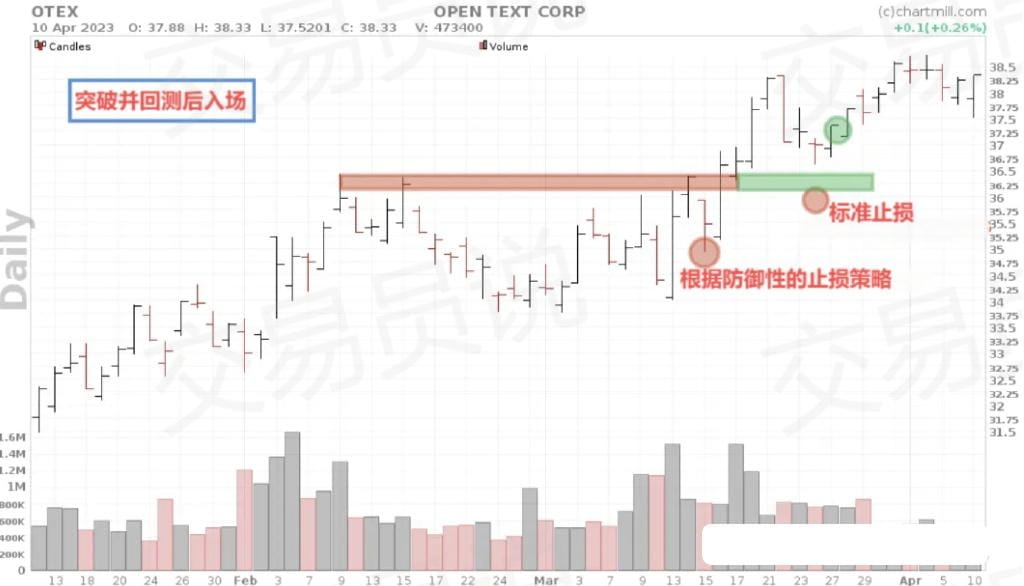
How to exit successful breakout trades?
After a successful breakout, properly managing the long positions opened is very important for achieving structural profits in the long run. Depending on your trading style, there are several ways to accomplish this.
1. Set price targets
Set price targets along with entry and stop-loss. Ensure your target is at least 1.5 times the initial stop-loss.
For example, if you buy a stock at 12.92 and set a stop-loss at 12.49, the risk per share is 0.43. Therefore, if we want the price target to be at least 1.5 times the risk, we need to achieve at least 0.65 profit (0.43 * 1.5). In this case, the minimum price target should be set at 13.56.
Assuming half of your trades hit stop-loss and the other half reach take-profit targets, this exit strategy can still yield profits.
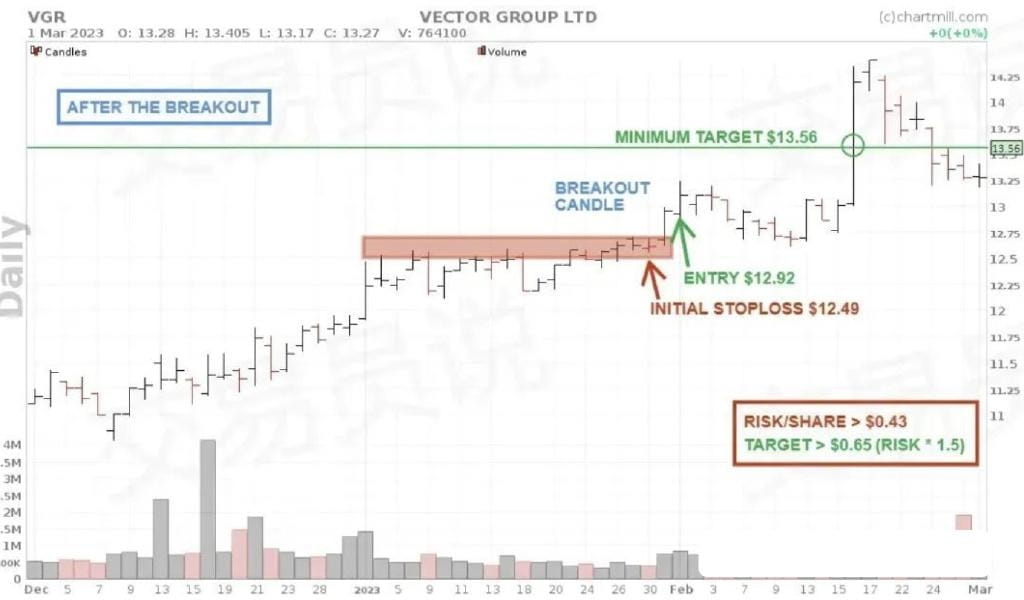
2. Use trailing stop-loss
This stop-loss method ensures that part of the accumulated profits is protected when prices drop. However, as long as prices rise, the trailing stop-loss will also increase, thus protecting a larger proportion of the profits.
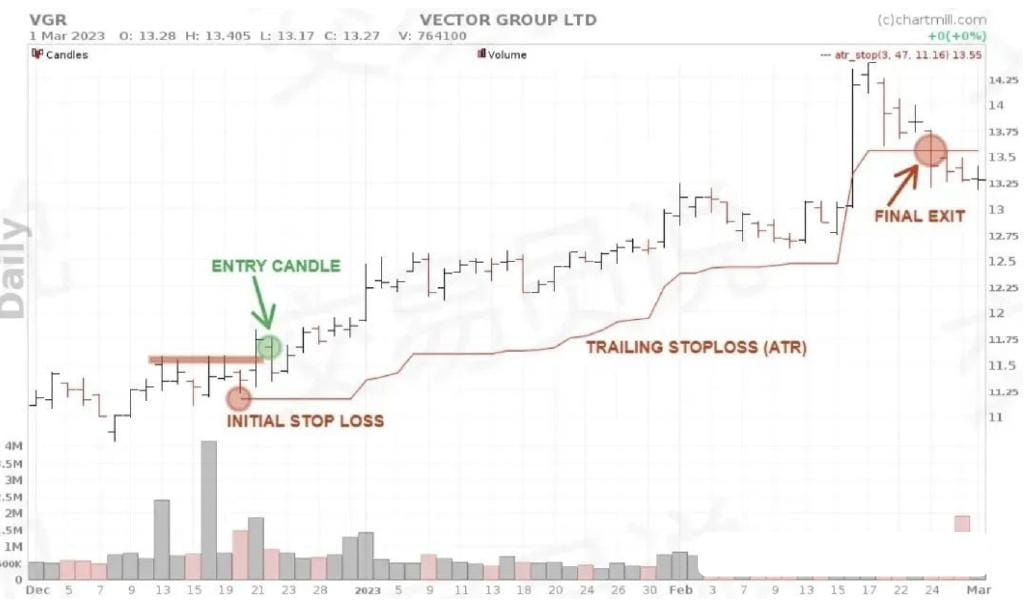
3. Use technical indicators
Many technical indicators can provide insights into price trends, helping you determine whether the existing trend is strengthening or weakening. Below, we will discuss several commonly used indicators that are helpful in this regard.
◎ RSI Indicator
This is a momentum oscillation indicator used to measure the speed and change of price movements. The default upper limit of this indicator is 70. Above this value is considered overbought.
Traders should pay attention to possible trend changes (short-term or long-term). In particular, divergences between the RSI indicator and prices should be closely monitored to detect price changes in the early stages.
◎ MACD Indicator
This is a trend-following momentum indicator composed of the MACD line and signal line. The MACD line crossing below the signal line can serve as an exit signal for existing long positions.
◎ Bollinger Bands
Bollinger Bands are used to monitor the volatility or degree of price fluctuations. They define the upper and lower limits of price movements based on the standard deviation of moving averages. If the price exceeds the upper limit (upper Bollinger Band), it may indicate an overreaction and could trigger a price drop. Based on this, existing long positions can be closed.
Be cautious when using technical indicators as exit signals. In strong trending movements, they can produce many false signals, leading to further price increases, causing you to miss out on significant profits for a long time.
It’s best to use indicators as warning signals. Instead of closing your position immediately, it’s better to use the exit signal to manually move the stop-loss slightly closer to the current price.
If the exit signal is accurate, you will eventually be stopped out (while retaining most of the profits). However, if the price continues to rise, you will continue to profit from the upward trend.
How to exit a failed breakout trade?
Just as it is crucial to manage profitable positions, properly managing losing positions is also essential. The only quick and effective way is to use hard stop-losses.
When using a breakout strategy, traders expect the trend to continue after the breakout. If the breakout fails to continue and the price drops again, stop-losses will ensure that losses are limited.
Previously, we mentioned the approximate positions of initial stop-losses in each option. In this regard, we want to emphasize two points:
1. Closely monitor important support levels and strategically set stop-losses below these support levels. If previous support fails to cause a price rebound, it is a strong signal that prices may decline further. Stop-losses will protect you from greater price drops.
2. Don't set the stop-loss too close to the current price. In this case, the stop-loss may trigger too early. In many cases, you will notice that the price moves in the desired direction shortly after. This can lead to a lot of frustration!
Summary
Key Points
1. Trading based on price breakouts is a great way to take full advantage of new market trends.
2. After confirming the breakout, always pay attention to momentum and volume before deciding to open positions.
3. The four methods of entering breakout trades include 'buying before the breakout,' 'buying at the breakout,' 'buying after the breakout,' and 'buying during a retracement to the breakout level.' Each method has its pros and cons.
4. Choose the method that best suits your personal trading style, as this can provide you with the greatest chance of success.
5. Risk management plays an equally important role in long-term success. A rational exit strategy to protect profits or limit losses is crucial in this regard.
Frequently Asked Questions
1. Can breakout trading be profitable?
In general, breakout trades can be very lucrative. Successfully identifying breakouts and entering at the right time can yield substantial profits, but there is always the risk of false breakouts or prices not moving as expected. Remember, no strategy can generate profits without encountering losses.
Therefore, achieving continuous profits through breakout strategies is closely related to reasonable risk and position management. To this end, ensuring exit strategies that maximize profits and minimize risks (whether for profitable or losing positions) is essential.
2. What is the ideal time frame for breakout trading?
Breakout trading can be done across different time frames. Breakout patterns can appear equally on 5-minute charts or monthly charts.
The ideal timeframe for breakout trading depends on several factors:
● Your trading style and strategy
● Current market sentiment and overall market trend
● The volatility of the financial products you trade
Short-term breakouts (entry and follow-up actions completed within a few hours to a few days) are mainly used by day traders and swing traders. They primarily use intraday charts (5 minutes, 15 minutes, 1 hour, etc.) to identify breakout areas.
Long-term breakouts (mainly aimed at participating early in sustained trends lasting several weeks or months) are the preferred area for position traders. They primarily focus on daily and weekly charts to determine when and where to enter.
3. How to avoid false breakouts in trading?
To avoid false breakouts as much as possible, you can take the following measures:
● Wait for confirmation of the breakout, with the price closing above the resistance level. While this may cause you to miss the actual breakout, it can also help avoid many false breakouts.
● Pay attention to additional confirmation factors supporting the breakout. A significant increase in volume before and after the breakout is the most important parameter. Avoid breakouts with only moderate volume.
● Observe long-term trends. Focus on varieties that have shown a clear long-term upward trend for upward breakouts.
● Consider the overall market trend and sentiment. Breakouts work best in a generally bullish market.
There's a saying I strongly agree with: the boundary of knowledge determines the boundary of wealth; one can only earn wealth within their knowledge boundary.
Maintain a good mindset when trading cryptocurrencies; do not let blood pressure rise excessively during downturns, nor become complacent during upswings. Locking in profits is essential.
For those with limited resources, being practical is the unbreakable way to survive; good luck! #名人MEME热潮 $BTC $ETH

